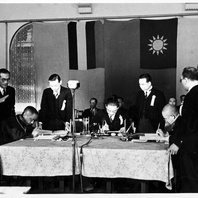
Item
Signing of Japan-Manchukuo-China Joint Declaration
Flanked by courtiers, Zang Shiyi, the Manchukuo ambassador to the RNG (seated to the left), Noboyuki Abe, Japanese ambassador to the RNG (seated to the right), and Wang Jingwei (seated in the centre) sign the Japan-Manchukuo-China Joint Declaration on 30 November 1940, through which RNG China recognised Manchukuo. The Declaration was attached to the Sino-Japanese Basic Treaty, through which Japan formally recognised the RNG. Both documents were signed within the main RNG government compound in Nanjing. The flags of Japan, China and Manchukuo are on the wall behind the men.
Read More
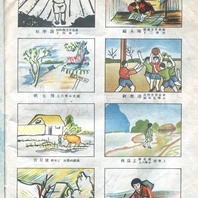
Item
Ertong zuopin (works by children), II
This is a selection of images (most being pencil drawings) contributed to the magazine Ertong huakan (Children’s Pictorial) 9.10 (April 1941) by readers. The images offer a fascinating insight into the ways in which official ideas about the appearance of occupied China were reflected in the artwork of Chinese school children living in the RNG capital. Note the references to dawn, for example, the depictions of Japanese people, and the idyllic images of the Chinese countryside included in some of the drawings. Basketball remained a politically acceptable sport in occupied Nanjing despite its American provenance.
Read More
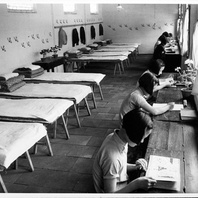
Item
Girls are all living in a dormitory [sic]
From a collection of staged photographs produced under the title “Life at a Girls School in Peking”, and produced at the Peking Jiyu Gakuen in Japanese-occupied Beijing. The original caption reads: “They are doing their ‘home works’ [sic]”.
Read More
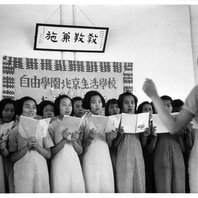
Item
A chorus group [sic]
From a collection of staged photographs produced under the title “Life at a Girls School in Peking”, and produced at the Peking Jiyu Gakuen in Japanese-occupied Beijing.
Read More
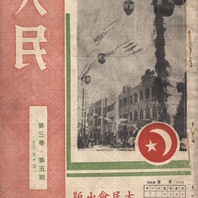
Item
Damin cover image, May 1940
This is the cover image of the magazine Damin 3.3 (May 1940), published by the Daminhui (Great People’s Association) in Nanjing. The Daminhui was a propaganda and mobilization organization established by the Japanese in 1938, which was later folded into Wang Jingwei’s Kuomintang (Nationalist Party). The Daminhui specialised in public expressions of support for the occupation, and employed a staff of Chinese organisers, artists, and writers. The sun-and-moon logo of the Daminhui can be seen on this magazine’s cover.
Read More
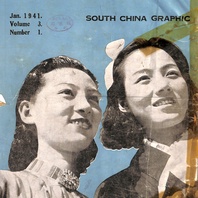
Item
Huanan huabao (South China Graphic) cover, January 1941
This cover image is taken from Huanan huabao (South China graphic) 3.1 (January 1941). The staged photograph deploys one of the standard tropes of Japanese propaganda in occupied China, i.e., that of a Japanese woman and Chinese woman fraternising with each other. This trope was derived from Manchukuo propaganda and the notion of “gozoku kyōwa” (“the harmony of the five races”), as well as attempts to feminise the image of an occupied China. Note how the Japanese woman is pictured as being slightly higher than her Chinese peer.
Read More
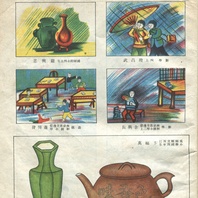
Item
Ertong zuopin (works by children), I
This is a selection of images (most being pencil drawings) contributed to the magazine Ertong huakan (Children’s Pictorial) 9.10 (April 1941) by readers. The images offer a fascinating insight into the ways in which official ideas about perceived notions of student behaviour in occupied China were reflected in the artwork of Chinese school children living in the RNG capital. Two of the drawings in this selection, for example, relate to the hardships of studying (in difficult weather, poor light, etc), while one depicts children playing in a classroom.
Read More
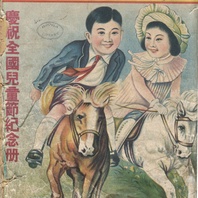
Item
Qiantu wuliang (An immeasurable future)
Cover of a magazine which was published in Nanjing for children themselves during the Japanese occupation. The artist who created this image is not named. Publication details are: Ertong huakan (Children’s Pictorial) 9.10 (April 1941): cover image
Read More
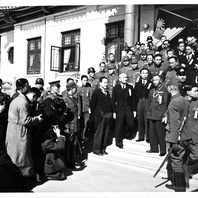
Item
RNG leaders on steps of Government Headquarters, November 1940
Flanked by civilian and military staff, Wang Jingwei, Zang Shiyi (the Manchukuo ambassador to the RNG) and Chu Minyi (RNG foreign minister) pose for photographs in front of the ceremonial hall (litang) in the national government compound in Nanjing after the signing of the Japan-Manchukuo-China Joint Declaration on 30 November 1940, through which RNG China recognised Manchukuo.
Read More
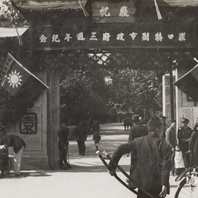
Item
Park in Wuhan, spring 1943
Photograph of a park in Wuhan festooned to “Celebrate the 3rd anniversary of the founding of the Hankou Municipal Government” (Qingzhu Hankou tebie shi zhengfu san zhounian jinian). While Wuhan is often remembered as a centre of anti-Japanese resistance in the early war years, it was also incorporated into the RNG realm in 1940, and became a major political and cultural centre for that administration. Interestingly, the ROC flag shown here still includes the RNG pennant (which read “peace, anti-communism, and nation building”, and which had been added to the flag in 1940), even though Chinese authorities in occupied areas were, from January 1943 onwards, not obliged to include this pennant.
Read More
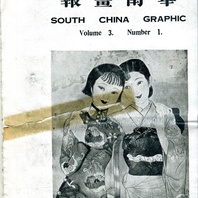
Item
Huanan huabao (South China Graphic) inside cover, January 1941
This image is taken from Huanan huabao (South China graphic) 3.1 (January 1941). The illustration deploys one of the standard tropes of Japanese propaganda in occupied China, i.e., that of a Japanese woman and Chinese woman fraternising with each other. This trope was derived from Manchukuo propaganda and the notion of “gozoku kyōwa” (“the harmony of the five races”), as well as attempts to feminise the image of an occupied China. Note how the Japanese woman is pictured as being slightly higher than her Chinese peer.
Read More
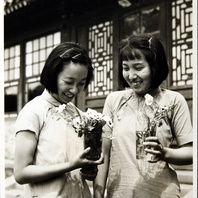
Item
Two girls picked flowers for the dinner table [sic]
From a collection of staged photographs produced under the title “Life at a Girls School in Peking”, and produced at the Peking Jiyu Gakuen in Japanese-occupied Beijing. The original caption reads: “Two girls picked flowers for the dinner table [sic]”.